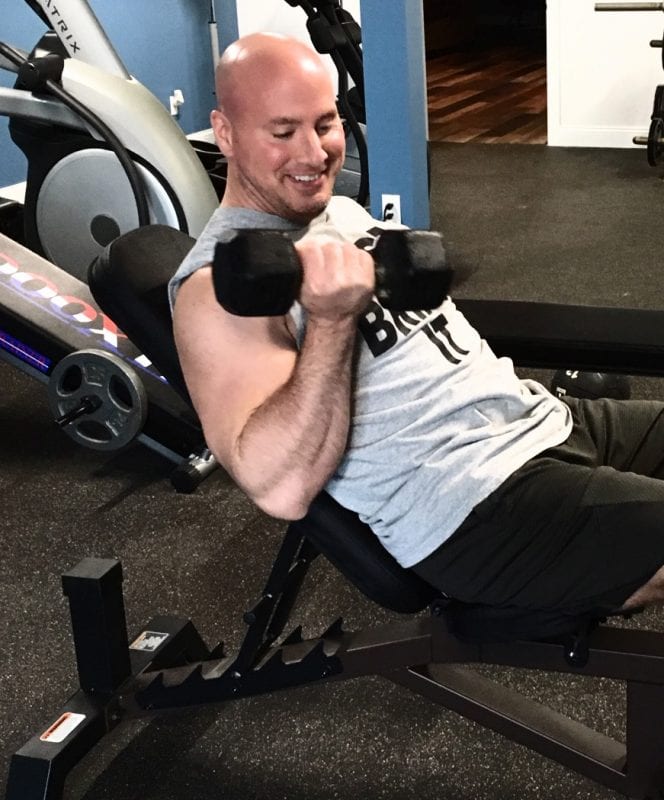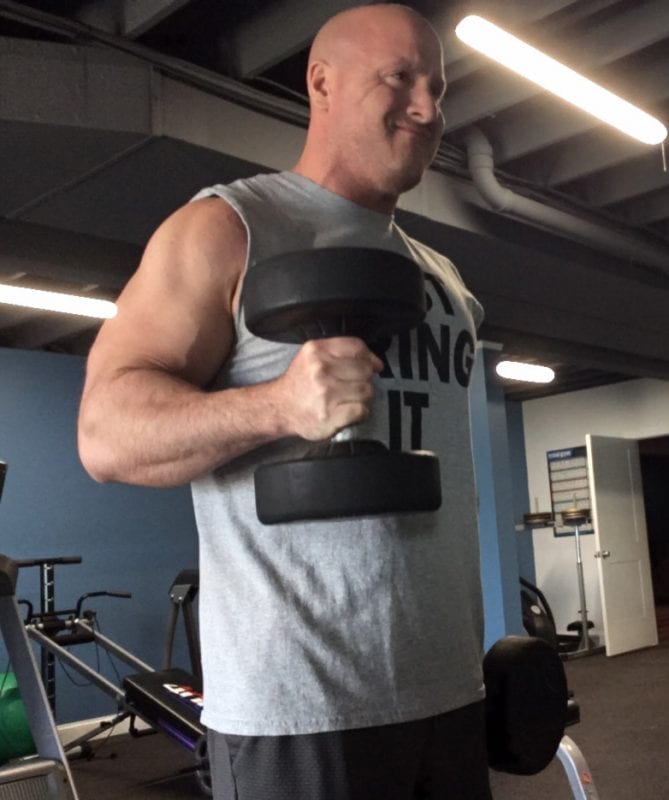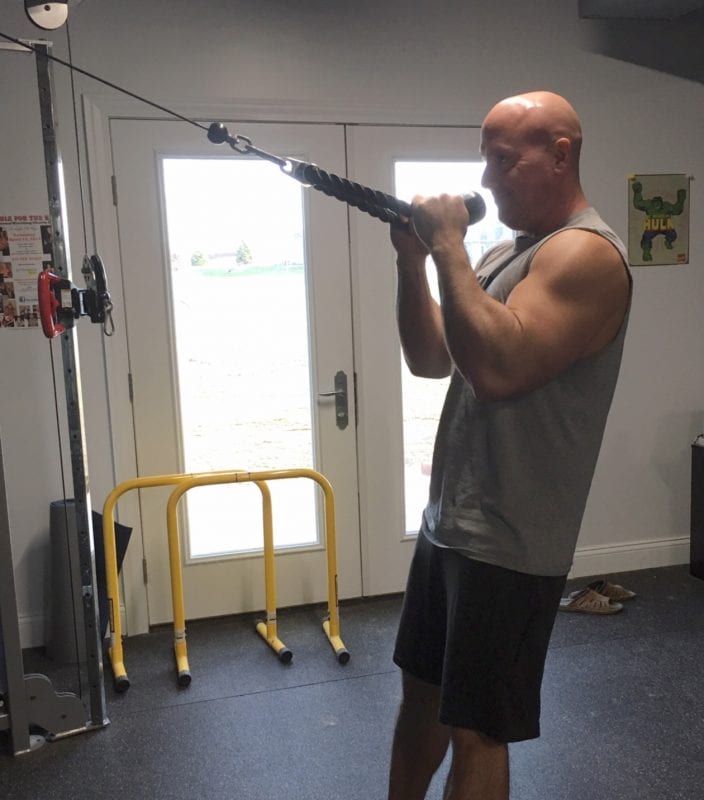The biceps are without doubt the most trained part of the human anatomy. Excusing the old as time bodybuilding joke about newbs curling in the squat rack, almost all peach fuzz rookies think training their guns will give them a well honed physique.
If you want to look like Spiderman with super skinny legs and a muscular upper body stick with this mentality.
The biceps only make up a third of the upper arm, so why train them as if your life depended on it?
Not everybody wants to look like a bodybuilder, but at least if you want to maintain some modicum of respect, you owe it to yourself to attempt to keep your upper body in line with the proportions of your lower body.
The biceps need only be trained once a week, or twice if you are on a split routine or ingesting steroids. If not you will certainly over train and over develop the biceps brachii and brachialis.
The biceps get a massive pump during most other upper body exercises, so they are going to grow even by doing secondary work. Even during squats they are active as you squeeze to hold onto the bar and push up from the hole.
And during deadlifts don’t you use these to pull the weight off the floor? No doubt.
As the bicep muscles are small compared with the quads for example they can recover at a faster rate especially if you have your rest and nutrition dialled in. But this is not the main reason you should not go overboard and train them 5 times a week.
The function of the bicep is to help shoulder and forearm adduction (movement towards and away from torso). In more scientific terms the bicep supinates (rotates upwards) the forearm with the elbow flexors.
It is also thought to aid in stabilizing the shoulder and the elbow joint.
Biceps Assistance In Major Lifts
The biceps come in to play in almost all exercises that involve you holding onto a bar or cable accessory. They do a lot of work on back days. Dorian Yates always said the weak point on back days was the biceps.
Meaning they would fatique before the lat muscles would. So instead of relying just on straps to help his grip from giving out first on pulldowns and barbell rows he would actually pre-exhaust the lats with a lat pullover machine.
That way it when he brought his back to failure it was because his lats actually gave out, and not his biceps. Ever noticed the reason you can’t do another lat pulldown, row or pullup? Could it be that burn in your biceps?
Dorian also very famously only trained each bodypart once-a-week.
Not all gyms have pullover machines, and one compromise is to do lat pullovers on a bench focusing all tension on the lats.
Lots of bodybuilders combine biceps and back on the same day. Known as a “pull” day, which involves all pulling motions. The famous push pull system is used by lots of people today, including many in my local gym. As Kincade said in Skyfall, sometimes the old ways are the best.
Your biceps should not be trained after a back day as they will get a lot of work that day and will not be fully recovered. You also have to remember that the triceps are twice the size of the biceps.
If you want thicker, fuller arms, you need to train triceps optimally, and not be that guy or gal with the bulging biceps, but nothing at the back of your arms. And if you are into proportion, is it better to have huge arms and a tiny back, or well rounded back with well proportioned arms and chest?
Yes genetics have a portion to play but you can certainly get ahead of yourself a develop certain body parts much better than others. Or you can just rip it to shreds and take it to the extremes that Greg Valentino did:
Yes Greg did create a Salvador Daliesque physique by combining anabolic steroids with synthol oil that is directly injected into the skin…
but now back to reality…
I like to train biceps and triceps on the same day. My fitness coach Ryan has put together a routine here. It focuses on all 4 strands of the bicep muscle, the long and short head, the brachialis and brachioradialis.
Whenever I feel like a change I will do back and biceps on the same day, with back obviously being hit first. I am also a big fan of bicep pullups, which although not invented by him, were made famous by Heavy Duty proponent Mike Mentzer.
Heavy Duty was his version of the push pull system, with maximum intensity. Something Dorian Yates went on to advance into more extreme territory.
I like to do my bicep pull ups 2 handed but this freakishly strong guy is doing it one handed. No wonder the bicep is strong, it allows you to move the forearm in a multitude of directions.
One handed pull ups are not really necessary to gain mass but it shows you just what you can do with the power of a single bicep.
To fully develop the biceps you need to hit all heads. You cannot do that with a single exercise so you need to incorporate a main mass developer, some preacher curl work (brings out bicep peak), and some incline bench work.
Main Biceps Mass Developer
My favorite all time bicep developer to start my routine with is barbell curls with the 6ft Olympic bar. I found it developed the thickness across my biceps better than anything else.
When I’m feeling really hardcore I’ll use the 7ft bar. Be careful on this, especially if you have wrist problems. Even if you haven’t i would only do this one once every couple of weeks, or on a blue moon, or whatever comes first….
Unfortunately like a lot of people I cannot no longer do bicep curls with a flat bar that often, due to the extreme force it puts on the wrists.
Due to the rotating axis of the radius (forearm bone) the wrist does not sit at a natural angle with a straight bar.
Occasionally I will use the Olympic bar with no weight added to it, but now I complete all on my main bicep curls with the EZ bar as it is less stressful on the wrists.
Here’s how to work both heads of the biceps (biceps brachii and biceps femoris).
Incline dumbbell curls

45 Degree Incline Dumbbell Curls
Incline dumbbell curls really work the often forgotten about long head of the biceps. This runs along the outside of the upper arm and contributes to the biceps peak. The short head runs along the inner side.
This section of the bicep is majorly stimulated when the arms travel behind the waist. Notice in most bicep exercises the arms are always in front of the waist.
That’s where the incline bench comes in. It allows you to extend your arms behind the waist, doing so puts the long head in a fully stretched position. Adding force here (weight) stimulates the muscles in a longer range of motion as oppossed to a preacher curl, which uses a short range of motion.
For balance, the long head can also be worked with hammer curls (see below). Many people think preacher curls work the biceps peak. They target the short head more specifically (brachialis) which makes up the lower portion of the bicep.
Preacher curls are excellent for stripping all momentum out of bicep curls. Whether you use an ez bar, or dumbbell, having your triceps locked against the pad ensures your shoulders and back have minimal input.
The bicep is a twin headed muscle (bi-articular) which is responsible for allowing you to move the shoulder and elbow joint. The role of the long head is actually unclear but no other bicep exercise I know causes me so much pain in maximum contraction and many bodybuilders believe this is the best exercise for working the long head.
If it aids to overall bicep growth I’m happy.
Use Hammer Curls To Thicken Cross Section of Biceps

Hammer curls are great for a few reasons. I only started doing them a few years back and they have helped thicken the width of my biceps. Placing the palms towards one another doesn’t seem natural, but it recruits the brachialis muscle more directly.
This muscle sits below the brachii muscle and once stimulated widens the bicep muscle considerably.
If you have a forearm injury or suffer from pain in this region this exercise does not cause a lot of strain in this area and can be your go to if you ever get a forearm injury and still want to pump the guns.
Using Cable Machines For Constant Tension
There’s nothing like the natural arc of using dumbbells or the long bar, but cables provide an alternative and complementary feature. They allow you to keep the biceps under tension throughout the complete rep range.
Resist on the way down to max out the load on the muscle. More muscle is actually built in the negative eccentric phase of a rep so you may as well max out the time under tension for maximum growth potential.
Lower the cable for double the length of time. For example explode up from the bottom in a sec and lower the cable back down for 2 seconds. Ryan shows you here how to do it with a cable on our bis and tris page. You’ll also find out the benefits of using a rope.

I like to incorporate both dumbbells and barbells and machines. You will lift more weight with a bar as you are using both hands, but you can split that weight and get a lot more range of motion with a dumbbell.
Machines allow you to use constant resistance, though the force does vary across the rep range depending on the machine.
This research study shows the importance of using free weights (barbells and dumbbells) and cable machines.
Working the muscle is a longer range of motion recruits extra muscle fibers, as opposed to working in a short range of motion. Both styles of serious positives so if you hit both you will cover all bases.
Are You Biceps Responding Faster Than Your Other Body parts?
The bicep is one of those muscles most people find easy to train. You use it so much everyday grabbing onto things, raising and lowering your hands, expressing yourself wildly in the board room…
It’s easy to grab a dumbbell and squeeze the heck out of that sucker…
Training the back for instance can be a lot harder for people, especially to get that mind-muscle connection, especially as you can’t see it directly or struggle to feel the finer points of it working.
The bicep is simple to activate. Bend 90 degrees at the elbow and squeeze it like it owes you some money. The trick is to squeeze it just before you begin the lift, that ensures your bicep is fully engaged and taking most of the stress.
Don’t sway the arms at all. Remain strict. Cheat curls are a different animal, and this technique should only be used, well…on cheat curls.
If you don’t know what these are, they involve doing a heavier weight than you can normally curl and using your whole upper body, right from the waist, swing from the fence until you haul the weight up. Pure momentum, but you feel it by lowering the weight and fighting against the resistance. Ok now and again, if not a little dangerous for the lower back.
Just Remember…Balance
With the biceps, it’s easy to get a pump and feel and see it responding. It’s not so easy for many people to get the same pump in the quads or the back. This is the reason why sometimes you have to back of training the biceps.
Unless you only want the short t-shirt arm bulge look. Me, I’m more into balance.
